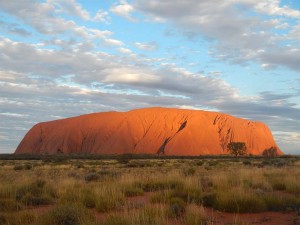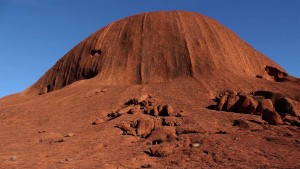I’ve always enjoyed Bill Bryson’s writing style, but I’ve often thought it would save a lot of time if every travel essay he ever wrote was titled “Things I Didn’t Get To Do OrSee Because I Didn’t Do Even The Minimal Amount Of Planning Ahead Of Time.” On the flight to Australia, I was reading Bryson’s travel musings in his book on Australia, and I found it hard to sympathize with the plight of only being able to spend an hour at Uluru, thanks to a shortage of hotel rooms at the nearby Yulara hotel complex. His disappointment seemed akin to maintaining a diet based on Pringles and Reese’s Peanut Butter Cups and then wondering where all that extra weight came from. What do you expect, is what I’m getting at.
Uluru is one of the most remote places on earth. It’s a five hour drive from anywhere – the definition of “anywhere,” and the only one that matters, being Alice Springs, which is itself more than a thousand kilometers from the next largest town – on a two lane road in the middle of the Australian outback. You have to want to get there. Once you do arrive, be prepared to stay a while, and don’t plan on finding many of the comforts of home. If you can’t find what you’re looking for at the gift shops, you aren’t finding it. That’s not necessarily bad, but it’s information you should have on hand, and well ahead of time.

Here’s the tradeoff, and it’s a good one: you’re in the presence of one of the world’s natural wonders. Uluru, once known as Ayers Rock, and still called simply “The Rock,” is a starkly singular presence, standing alone in the desert. Almost five kilometers in circumference and nearly eight hundred meters high… you want to see this for yourself. Other than the Grand Canyon, Uluru is the only place for which I’ve found room for the phrase “pictures don’t do it justice.”
Says the filmmaker.
You want o take Uluru in and explore it. This is not the world’s largest ball of twine. It demands your time, attention and I might even say it demands your respect. You plan ahead and get a hotel room, is what I’m saying. Especially if your job is to write about it for a living.
So let’s talk about Uluru.

Uluru has occupied a prominent place in my mind since I first read about it more than twenty years ago. It’s one of those places where you cannot use the phrase, “Oh, Uluru. It’s kind of like…” because there isn’t a way to complete that sentence. While the ecological conditions that created Uluru exist in many places – eastern Utah and southern Colorado come to mind – it’s the solitary bulk of Uluru that makes it stand out. While Kata Tjuta is a part of the landscape and sites like Devil’s Marbles, off the highway between Alice and Darwin, may strike a chord, standing in the shadow of the only prominent natural landmark of any significant height for many, many kilometers in any direction… it has an effect on you, even from a distance.
The Anangu Aboriginal tribe certainly thinks so. Uluru has been a sacred site for thousands of years. When Uluru was returned to Anangu ownership and given back its original name, rather than Ayers Rock, it was a very big deal. Relations between the native peoples of Australia and the descendants of white settlers is still very much a sore subject, and difficult waters for any traveler to navigate. However, for the most part, there is agreement on the subject of Uluru… that forty thousand years of history does give a people some sort of legitimate claim.
The land is managed by Parks Australia, and including this World Heritage Site in The Palette Project, was mandatory. Uluru was what one of my news directors would have called a must+cover, but unlike a Kiwanis Club lifetime achievement award for the wife of the station manager, this was a must-cover with some meaning. As the centerpiece for the Red portion of the documentary, traveling to the Red Centre of Australia without including Uluru would have been a glaring absence.
Thankfully, attitudes about commercial photography of Uluru – at least as far as documentary filmmaking is concerned – are starting to loosen. Our initial research into filming Uluru was not promising. A local producer in Alice Springs was succinct.
“Don’t even bother,” he said in response to my email inquiry for advice. He had been denied permits on no fewer than three occasions, and had several stories, also related on his company’s website, about the lengths Parks Australia officials had gone to restrict footage. Even with a permit, it’s not an easy gig. As we submitted our permit applications, along with the $500 nonrefundable application fee, it felt like we were doing little more than contributing to the Parks Australian budget. I was hanging my hat on multiple conversations I’d had with actual ranges on the grounds, which seemed promising. They loved the idea of a visually impaired photographer experiencing Uluru. Our application made it clear that we were not interested in the quick hit, or in making a quick buck off of The Rock. I was coming to Uluru in order to learn for myself how to experience this visual stunner when one’s sense of vision was more than a little wonky.
However, it was a nerve wracking month, waiting for the verdict on our application. We prepared our backup plans for shooting the majesty of King’s Canyon, plotting our shoots in Alice Springs and along the Lassiter and Stuart highways. We debated the wisdom of guerrilla shooting at Uluru and visiting other nearby sites (nearby being a relative term in the outback, as anything closer than five hundred kilometers away counts as close). There would be a lot of red to shoot for this leg of the film, but still… I wanted Uluru.
As we came to the end of the Lassiter Highway (it ends at Uluru) on final approach, I remembered what it felt like when the notice finally arrived. The big thumbs up that our permit application had been approved. It seemed so easy in retrospect, but the hard part was just beginning. Our permit gave us permission to be there with a camera. That was step one. Two difficult days of shooting were staring us in the face… and I was thrilled to the core.
More on Uluru next week, but I’ll tell you this: Bryson, you shoulda gotten those hotel reservations early, because you missed out on a lot.
